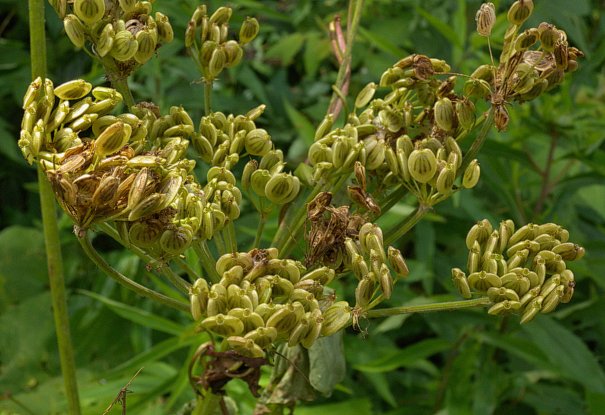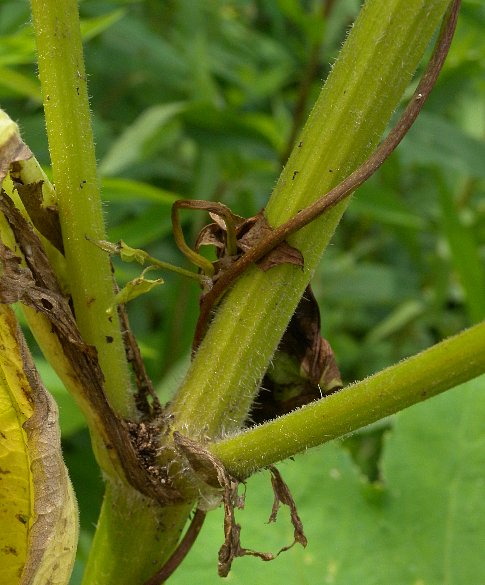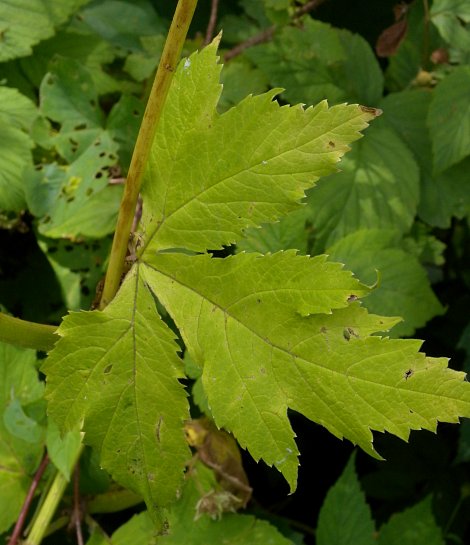
The central stem terminates in a compound umbel up to 8" across. Additional compound umbels are produced from the axils of upper leaves on long peduncles (flowering stalks); these axillary umbels are up to 6" across. The compound umbels are more or less flat-headed. Each compound umbel has 8-30 rays that terminate in umbellets; each umbellet has 8-30 flowers. The rays of the compound umbels are 2-5" long, light green, and pubescent; the pedicels of the flowers are ¼–¾" long, light green, and pubescent. Individual flowers span a little less than ¼" across. Each flower has a light green calyx that is shaped like a saucer, 5 white petals, 5 stamens, and a whitish ovary with a pair of tiny styles. The petals are strongly incurved at their tips. The blooming period occurs from late spring to mid-summer, lasting about 1 month. Afterwards, the flowers are replaced by fruits (schizocarps); each fruit consists of a pair of seeds. Individual immature fruits are about 8 mm. (1/3") in length, 6 mm. (1/4") across, and somewhat flattened; they are elliptic-obovoid in shape, light green with white margins, and there are 4 vertical dark green veins toward the center of each flattened side. Mature fruits become tan to dark brown, and their lateral margins become flattened into wings; they are distributed to a limited extent by the wind before dividing into seeds. The root system consists of a taproot or a cluster of thick roots. This plant reproduces by reseeding itself.

Cultivation: The preference is full sun to light shade, moist conditions, and fertile soil containing loam, silty loam, or sandy loam. The size of individual plants can vary considerably. Some protection from strong wind is desirable. Because Cow Parsnip can irritate human skin, it is best to wear gloves while handling its foliage.
Range & Habitat: The native Cow Parsnip is occasional in central and northern Illinois, while in the southern section of the state it is uncommon (see Distribution Map). Habitats include bottomland woodlands, terraces of floodplain woodlands, borders of woodlands, woodland openings, meadows in wooded areas, riverside prairies, thickets, streambanks, and partially shaded roadsides. Cow Parsnip can be found in both high quality natural areas and disturbed habitats.

Faunal Associations: The flowers of Cow Parsnip attract a large diversity of insects because of its easily accessed nectar and pollen. These floral visitors include honeybees, cuckoo bees (Nomada spp., Sphecodes spp.), plasterer bees (Colletes spp.), masked bees (Hylaeus spp.), Andrenid bees, Halictid bees, Sphecid wasps, Vespid wasps, spider wasps (Anoplius spp., etc.), Tiphiid wasps, Ichneumonid wasps, dark-winged fungus gnats (Sciara spp.), soldier flies (Stratiomys spp., etc.), Syrphid flies, dance flies (Empis spp., Rhamphomyia spp.), Tachinid flies, flesh flies (Ravinia spp., Sarcophaga spp., etc.), blow flies (Lucilia spp., etc.), Muscid flies, frit flies (Liohippelates spp., Olcella spp.), long-horned beetles (Strangalepta spp., Trigonarthris spp., etc.), tumbling flower beetles (Mordellidae), flower chafers (Trichiotinus spp., etc.), plant bugs (Miridae), and occasional butterflies (Robertson, 1929; Gosling, 1986). Some insects feed destructively on the foliage, fruit, and sap of cow parsnip. These insect feeders include the larvae of leaf-mining flies (Phytomyza spp., etc.), larvae of Euleia heraclei (Hogweed Picture-wing Fly), larvae of Depressaria pastinacella (Parsnip Webworm Moth), Orthops scutellatus (Carrot Plant Bug), Taeniothrips vulgatissima (Cow Parsnip Thrips), and such aphids as Aphis decepta, Cavariella aegopodii (Willow-Carrot Aphid), Cavariella pastinacae (Willow-Umbellifer Aphid), and Cavariella theobaldi (Willow-Parsnip Aphid); see Needham et al. (1928), Knight (1941), Stannard (1968), and Blackman & Eastop (2013). Some mammals feed on the flowers and foliage of Cow Parsnip, particularly in the western United States. There are records of bears, elk, deer, cattle, horses, and sheep feeding on this plant (Esser, 1995). However, when this plant is exposed to the ultraviolet radiation of sunlight, the foliage can become phytotoxic, causing blisters to form on the skin and possible irritation of the digestive tract (Georgia, 1913). This toxic side effect is the result of light-sensitive furanocoumarins. Cow Parsnip shares this characteristic with another species in the Carrot family, Pastinaca sativa (Parsnip).

Photographic Location: Border of a woodland along a road at Illinois Beach State Park in NE Illinois.
Comments: Because of the large size of its compound umbels, Cow Parsnip is one of the best sources of nectar and pollen for a wide variety of insects, especially small bees, wasps, flies, and beetles. This plant can be distinguished from other species in the Carrot family primarily by its large size (up to 8' tall or more), large ternately divided leaves, and hairy foliage. Other scientific names of Cow Parsnip include Heracleum lanatum and Heracleum sphondylium montanum. The latter scientific name, Heracleum sphondylium, refers to European Cow Parsnip. This plant species has compound leaves with 3-7 pinnately arranged leaflets, while the Cow Parsnip of North America, Heracleum maximum, has only 3 leaflets per compound leaf. Both plant species are about the same size. A third species that is native to Eurasia, but has naturalized in parts of North America, is Heracleum mantegazzianum, or Giant Hogweed. This is a much larger plant that becomes 6-18' tall at maturity. The compound leaves of Giant Hogweed are also larger in size than the preceding plant species in its genus; they are pinnate-pinnatifid or pinnate-bipinnatifid with narrowly acute lobes.